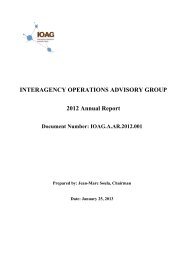OLSG Report_Final_06_05_12 - Interagency Operations Advisory ...
OLSG Report_Final_06_05_12 - Interagency Operations Advisory ...
OLSG Report_Final_06_05_12 - Interagency Operations Advisory ...
Create successful ePaper yourself
Turn your PDF publications into a flip-book with our unique Google optimized e-Paper software.
2.4.5 Weather and Atmospheric Monitoring Equipment<br />
Optical Link Study Group (<strong>OLSG</strong>) <strong>Final</strong> <strong>Report</strong><br />
IOAG.T.<strong>OLSG</strong>.20<strong>12</strong>.V1<br />
The weather and atmospheric conditions play a significant role in optical communications<br />
link availability and quality and it is necessary to automatically monitor these parameters at<br />
the Earth stations for real-time and historical analysis and link handover decision making.<br />
• Weather: Weather information is gathered locally by standard meteorological<br />
packages that monitor temperature, humidity, barometric pressure, and wind<br />
speed and direction.<br />
• Clouds: A thermal infrared cloud camera is used to monitor the extent of cloud<br />
coverage, in addition to the satellite data discussed in the CFLOS discussion<br />
(Section 2.2.1.2) above. These sensors indicate not only whether there are<br />
clouds or no clouds at very high temporal resolution, but also the sky<br />
temperature and emission.<br />
• Daytime Sky Radiance: A sun photometer provides this measurement.<br />
• Atmospheric Loss: During the day, a sun photometer is also used to measure<br />
atmospheric loss. At night, a calibrated photometric system that tracks stars of<br />
stable emission, e.g., Polaris, can be used.<br />
• Clear Air Optical Turbulence: A Differential Image Motion Monitor (DIMM) is the<br />
predominant method of measuring seeing. During the night this instrument<br />
tracks stars and during the day, the Sun.<br />
2.4.5.1 Ground Station Weather Instrumentation<br />
Various types of cloud instrumentation have been proposed to support operational free<br />
space optical communications. This instrumentation would be used to perform link<br />
handover decisions in the event that multiple sites have simultaneous visibility to the space<br />
terminal. These instruments include both day/night visible and long-wave infrared cameras<br />
(see Figure 8). Such instrumentation can provide quantitative depiction of clouds<br />
throughout the skydome with time resolutions on the order of a minute. These high<br />
resolution images of clouds can be used to support very near-term predictions of cloud<br />
cover in the line of sight to the space terminal. If longer-term cloud forecasts are required,<br />
use of imagery from meteorological satellites may be desirable. In any case, more research<br />
on placing these instruments into operations should be conducted.<br />
Page | 33



